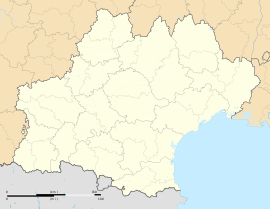Alliat (French pronunciation: [alja]; Occitan: Aliat) is a commune in the Ariège department and Occitanie region in southwestern France.
Alliat | |
|---|---|
 The entrance to the La Vache Cave | |
| Coordinates: 42°49′05″N 1°35′14″E / 42.8181°N 1.5872°E | |
| Country | France |
| Region | Occitania |
| Department | Ariège |
| Arrondissement | Foix |
| Canton | Sabarthès |
| Intercommunality | Pays de Tarascon |
| Government | |
| • Mayor (2020–2026) | Marie-Françoise Kalandadze[1] |
Area 1 | 3.46 km2 (1.34 sq mi) |
| Population (2021)[2] | 56 |
| • Density | 16/km2 (42/sq mi) |
| Time zone | UTC+01:00 (CET) |
| • Summer (DST) | UTC+02:00 (CEST) |
| INSEE/Postal code | 09006 /09400 |
| Elevation | 500–1,268 m (1,640–4,160 ft) (avg. 560 m or 1,840 ft) |
| 1 French Land Register data, which excludes lakes, ponds, glaciers > 1 km2 (0.386 sq mi or 247 acres) and river estuaries. | |
Geography
editCommune in the "Haute-Ariège" part of the Pyrenees located 15 km from the city of Foix and 5 km from the city of Tarascon-sur-Ariège, in the "Parc naturel régional des Pyrénées ariégeoises".
Population
editInhabitants of Alliat are called Alliatois.
| Year | Pop. | ±% p.a. |
|---|---|---|
| 1968 | 71 | — |
| 1975 | 68 | −0.61% |
| 1982 | 65 | −0.64% |
| 1990 | 55 | −2.07% |
| 1999 | 62 | +1.34% |
| 2007 | 66 | +0.78% |
| 2012 | 58 | −2.55% |
| 2017 | 51 | −2.54% |
| Source: INSEE[3] | ||
Sights
edit- The "cave of the cow" (grotte de La Vache): with distinctive archeological strata discovered in its entrance and in the "salle Monique", opened to the public in 1979. It produced a remarkably rich collection of prehistorical objects from the Magdalenian era (12,000 to 14,000 years old), including a large number of harpoons and assegai points as well as more than 200 pieces of art: bones, engraved reindeer and red deer antlers, sculpture of animals, sometimes of humans, as well as rare species for that period: panther, bear, wolves, Saiga antelope, birds and salmon.
- It was one of the first caves explored in Ariège (Félix Garrigou, in 1866). A second salle was discovered in 1952 and was explored by its discoverer, Romain Robert, until 1964.
- Fortified cave Spoulgas d’Alliat: located 100 m south of the cave of the cow.[4]
Activities
edit- Rock climbing around the caves
- Horse riding
See also
editReferences
edit- ^ "Répertoire national des élus: les maires" (in French). data.gouv.fr, Plateforme ouverte des données publiques françaises. 13 September 2022.
- ^ "Populations légales 2021" (in French). The National Institute of Statistics and Economic Studies. 28 December 2023.
- ^ Population en historique depuis 1968, INSEE
- ^ Maps and descriptions available in "Monographies villageoises en Sabarthès", Florence Guillot, 1999.
Wikimedia Commons has media related to Alliat.


